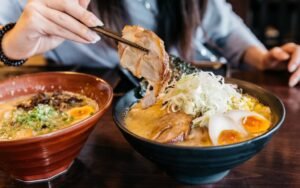Ramen: Exploring the Regional Variations Across Japan
- By -Maria Mash
- Posted on
- Posted in Culture
Ramen, a beloved Japanese noodle dish, has a relatively recent history compared to other traditional Japanese foods. Though its exact origins are debated, ramen is widely believed to have been introduced to Japan from China in the early 20th century. Initially enjoyed primarily in Japanese-Chinese eateries, ramen evolved over the decades into a distinctly Japanese dish. By the post-war era, it had become a staple of Japanese cuisine, with its various regional styles reflecting the diverse culinary traditions of Japan. Today, ramen is celebrated for its rich flavors, customizable toppings, and its ability to adapt to local tastes and ingredients.

Tonkotsu Ramen: A Rich and Creamy Delight
Originating from Fukuoka on the island of Kyushu, tonkotsu ramen is known for its rich, creamy broth made from simmering pork bones for several hours. The result is a deeply flavorful, milky soup that pairs perfectly with thin, straight noodles. Tonkotsu ramen is often garnished with ingredients like sliced chashu (braised pork belly), green onions, bamboo shoots, and pickled ginger. The robust flavor of the broth and the tender pork make tonkotsu ramen a favorite among those who enjoy hearty, savory dishes.
Shoyu Ramen: A Classic Soy Sauce-Based Broth
Shoyu ramen is a classic style originating from Tokyo, characterized by its clear, brown broth made from a base of soy sauce. This type of ramen features a more delicate and nuanced flavor compared to the rich tonkotsu ramen. The broth is typically flavored with chicken, pork, or fish stock, and seasoned with soy sauce, creating a balanced umami taste. Shoyu ramen is usually served with curly noodles and topped with ingredients like sliced pork, bamboo shoots, green onions, and nori (seaweed). Its light yet savory profile makes it a popular choice for those who prefer a more subtle broth.
Miso Ramen: A Flavorful Twist
Miso ramen, originating from Hokkaido in northern Japan, stands out with its hearty and flavorful broth made from miso paste. The miso adds a distinct umami depth and a touch of sweetness to the broth, which is often paired with thick, wavy noodles. Miso ramen is typically topped with ingredients like corn, butter, bean sprouts, and pork. This style of ramen is especially popular in colder regions due to its warming, rich taste, which provides comfort during the winter months.
Shio Ramen: A Light and Clear Broth
Shio ramen, which translates to “salt ramen,” is known for its clear, light broth made from a combination of chicken or pork stock and salt. Originating from the Kanagawa Prefecture, shio ramen offers a clean and refreshing flavor, emphasizing the quality of the broth rather than bold seasonings. The clear broth is complemented by thin, straight noodles and simple toppings such as sliced chicken, green onions, and a soft-boiled egg. Shio ramen is ideal for those who appreciate a more delicate and understated flavor.
Tsukemen: Dipping Noodles for a Unique Experience
Tsukemen, or “dipping noodles,” offers a different take on the traditional ramen experience. Instead of serving the noodles in the broth, the noodles and broth are served separately. Diners dip the cold, chewy noodles into the hot, concentrated broth before eating. Originating from Tokyo, tsukemen is typically accompanied by a rich, flavorful dipping sauce made from pork or chicken stock, soy sauce, and various seasonings. This style of ramen allows for a more intense flavor experience and is particularly popular among those who enjoy customizing their noodle-to-broth ratio.
Regional Variations and Local Specialties
Japan’s diverse ramen culture is reflected in the numerous regional variations found across the country. For example:
- Hakata Ramen: Known for its rich, creamy tonkotsu broth and thin, straight noodles, this style originates from Fukuoka and is often garnished with pickled ginger and green onions.
- Kitakata Ramen: Hailing from Kitakata in Fukushima Prefecture, this ramen features a soy-based broth with thick, flat noodles and a mild, savory flavor.
- Onomichi Ramen: From Onomichi in Hiroshima Prefecture, this ramen is characterized by its soy-based broth with a light, clear taste and slightly wavy noodles.
- Sapporo Ramen: Popular in Hokkaido, this style is known for its miso-based broth and hearty toppings like corn and butter.
These regional specialties showcase the local flavors and ingredients that define each area, making ramen a truly versatile and regionally varied dish.
Ramen and Its Cultural Impact
Ramen has become more than just a meal in Japan; it is a cultural phenomenon that reflects the country’s culinary creativity and regional diversity. The popularity of ramen extends beyond Japan’s borders, with ramen shops and instant ramen products gaining global recognition. Ramen festivals and competitions are held across Japan, celebrating the art of ramen-making and encouraging innovation within the ramen community. The dish has also inspired a wide range of culinary adaptations and fusion creations, further highlighting its impact on global cuisine.
The Future of Ramen: Innovation and Tradition
As ramen continues to evolve, it blends traditional techniques with modern innovations. Chefs are experimenting with new flavors, ingredients, and cooking methods to push the boundaries of ramen. Fusion styles that incorporate international ingredients or unconventional toppings are becoming increasingly popular. Despite these innovations, the core principles of ramen—attention to detail, quality ingredients, and a deep respect for tradition—remain at the heart of this beloved dish. The future of ramen promises to be as diverse and exciting as its past, ensuring that it will continue to captivate and inspire food enthusiasts around the world.
Conclusion
Ramen is a dynamic and multifaceted dish that embodies the rich culinary diversity of Japan. From the creamy tonkotsu of Kyushu to the light shio ramen of Kanagawa, each regional variation offers a unique taste experience that reflects local traditions and ingredients. As ramen continues to gain global acclaim, its blend of tradition and innovation ensures that it will remain a cherished culinary delight for years to come. Whether enjoyed in its classic form or through modern adaptations, ramen stands as a testament to Japan’s culinary creativity and the enduring appeal of this beloved noodle dish.



